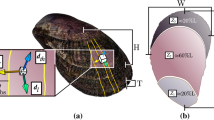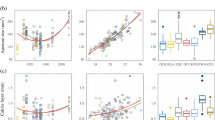Abstract
Polyplacophoran molluscs show low morphological diversity compared to other marine invertebrate clades, yet chitons are ecologically important grazers that occupy a range of distinct ecological niches. We investigated a potential functional correlate of niche separation in three species of co-occurring mopallid chitons that have total ranges across differing environments (Mopalia muscosa, Mopalia lignosa, Katharina tunicata). We found that the force needed to fracture the protective valves varied significantly among species. K. tunicata, whose valves have a relatively reduced exposed dorsal surface, was significantly more resistant to fracture than the two Mopalia species (mean force: K. tunicata = 31.9 ± 4.5 N; M. lignosa = 12.5 ± 0.8 N; M. muscosa = 20.2 ± 0.8 N). In Mopalia spp., the terminal valves were significantly stronger than intermediate valves (i.e. higher force to fracture), whereas all valves in K. tunicata appeared to be functionally equivalent. To assess whether future chemical changes predicted under ocean acidification (OA) will affect these species differently, we measured the force to fracture of valves after 10 days of exposure to elevated pCO2 (control = 8.0 pH [407 ± 104, pCO2], elevated = 7.5 pH [1544 ± 249, pCO2]) for both live animals and dissected individual valves. Although previous experimental OA work found significant impacts of elevated pCO2 on adult mollusc shells over similar timescales, we saw no reduction in total strength related to treatment. Our data demonstrate that diversity in chiton valve morphology has functional implications and that physical changes in local topology and wave exposure may have stronger impacts on adult chitons than changes in ocean chemistry under future climate change.


Similar content being viewed by others
References
Andrus JK, Legard WB (1975) Description of the habitats of several intertidal chitons (Mollusca: Polyplacophora) found along the Monterey Peninsula of central California. Veliger 18(Suppl):3–8
Bergenhayn JRM (1930) Die Loricaten von Dr. Sixten Bocks Pazifik-Expedition 1917–1918, mit spezieller Berücksichtigung der Perinotumbildungen und der Schalenstruktur. Göteborgs Kungliga Vetenskaps-och Vitterhets-Samhälles Handlingar Ser B 1:1–52, pls. 1–3
Byrne M (2011) Impact of ocean warming and ocean acidification on marine invertebrate life history stages: vulnerabilities and potential for persistence in a changing ocean. Oceanogr Mar Biol Annu Rev 49:1–42
Carey N, Sigwart JD (2014) Size matters: body size modulates responses to ocean acidification and temperature. Biol Lett 10. Article ID: 20140408
Connors MJ, Ehrlich H, Hog M, Godeffroy C, Araya S, Kallai I, Gazit D, Boyce M, Ortiz C (2012) Three-dimensional structure of the shell plate assembly of the chiton Tonicella marmorea and its biomechanical consequences. J Struct Biol 177:314–328
Dethier MN, Duggins DO (1984) An “indirect commensalism” between marine herbivores and the importance of competitive hierarchies. Am Nat 124:205–219
Eernisse DJ (1988) Reproductive patterns in six species of Lepidochitona (Mollusca: Polyplacophora) from the Pacific Coast of North America. Biol Bull 174:287–302
Elahi R, Sebens KP (2013) Experimental removal and recovery of subtidal grazers highlights the importance of functional redundancy and temporal context. PLoS ONE 8:e78969
Feely RA, Sabine CL, Lee K, Berelson W, Kleypas J, Fabry VJ, Millero FJ (2004) Impact of anthropogenic CO2 on the CaCO3 system in the oceans. Science 305:362–366
Gazeau F, Parker LM, Comeau S, Gattuso J-P, O’Connor WA, Martin S, Pörtner HO, Ross PM (2013) Impacts of ocean acidification on marine shelled molluscs. Mar Biol 160:2207–2245
Gutowska MA, Melzner F, Pörtner HO, Meier S (2010) Cuttlebone calcification increases during exposure to elevated seawater pCO2 in the cephalopod Sepia officinalis. Mar Biol 157:1653–1663
IPCC (2007) Climate change 2007: an assessment of the intergovernmental panel on climate change, pp 1–52
Kaas P, Van Belle R (1994) Monograph of living chitons, vol 5. E.J. Brill, Leiden
Kreusch B (1981) Etude Comparée de la Structure et de la Composition Chimique des Formations Squelettiques chez les Mollusques Polyplacophores. University de Liége, Mémoire de Licence en Sciences Zoologiques, Faculté des Sciences, Belgium, p 50
Linsenmeyer TA (1975) The resistance of five species of polyplacophorans to removal from natural and artificial surfaces. Veliger 18(Suppl):83–86
Murray SN, Ambrose RF, Dethier MN (2006) Monitoring rocky shores. University of California Press, Berkeley
Nienhuis S, Palmer R, Harley CDG (2010) Elevated CO2 affects shell dissolution rate but not calcification rate in a marine snail. Proc R Soc B 277:2553–2558
Orr JC, Fabry VJ, Aumont O, Bopp L, Doney SC, Feely RA, Gnanadesikan A, Gruber N, Ishida A, Joos F, Key RM, Lindsay K, Maier-Reimer E, Matear R, Monfray P, Mouchet A, Najjar RG, Plattner GK, Rodgers KB, Sabine CL, Sarmiento JL, Schlitzer R, Slater RD, Totterdell IJ, Weirig MF, Yamanaka Y, Yool A (2005) Anthropogenic ocean acidification over the twenty-first century and its impact on calcifying organisms. Nature 437:681–686
Puchalski SS, Johnson CC (2009) Preservation potential of Katharina tunicata and Mopalia muscosa (Mollusca, Polyplacophora) on two rocky shores of San Juan Island, Washington, USA. Lethaia 42:167–178
R Core Team (2014) R: A language and environment for statistical computing. R Foundation for Statistical Computing, Vienna, Austria. http://www.R-project.org/
Ries JB, Cohen AL, McCorkle DC (2009) Marine calcifiers exhibit mixed responses to CO2-induced ocean acidification. Geology 37:1131–1134
Schwabe E (2010) Illustrated summary of chiton terminology (Mollusca, Polyplacophora). Spixiana 33:171–194
Sigwart JD, Carey N (2014) Grazing under experimental hypercapnia and elevated temperature does not affect the radula of a chiton (Mollusca, Polyplacophora, Lepidopleurida). Mar Environ Res 102:73–77
Sigwart JD, Stoeger I, Knebelsberger T, Schwabe E (2013) Chiton phylogeny (Mollusca: Polyplacophora) and placement of the enigmatic species Choriplax grayi (H. Adams & Angas, 1864). Invertebr Syst 27:603–621
Sigwart JD, Lyons G, Fink A, Gutowska A, Murray D, Melzner F, Houghton JDR, Hu MY (2015) Ocean acidification drives lower growth and yet increased calcification in the early life history of the cuttlefish Sepia officinalis (Mollusca: Cephalopoda). ICES J Sea Res. doi:10.1093/icesjms/fsv188
Sirenko B (2006) A new outlook on the system of chitons (Mollusca: Polyplacophora). Venus 65:27–49
Speiser D, Eernisse DJ, Johnson S (2011) A chiton uses aragonite lenses to form images. Curr Biol 21:665–670
Tucker JS, Giese AC (1959) Shell repair in chitons. Biol Bull 116:318–322
Tunnicliffe V, Davies KTA, Butterfield DA, Embley RW, Rose JM, Chadwick WW (2009) Survival of mussels in extremely acidic waters on a submarine volcano. Nat Geosci 2:344–348
Vendrasco MJ, Fernandez CZ, Eernisse DJ, Runnegar B (2008) Aesthete canal morphology in the Mopaliidae (Polyplacophora). Am Malacol Bull 25:51–69
Vinther J, Jell P, Kampouris G, Carney R, Racicot RA, Briggs DEG (2012) The origin of multiplacophorans—convergent evolution in Aculiferan molluscs. Palaeontology 55:1007–1019
Acknowledgments
The authors thank the director and staff of University of Washington Friday Harbor Labs, in particular Dr Emily Carrington (for access to the ocean acidification facilities) and Dr. Adam Summers (for access to materials testing facilities). We also thank Dr. Nick Carey (Queen’s University Belfast) for help with the experimental animals. PAG was funded by a Friday Harbor Labs scholarship. Geerat Vermeij and an additional reviewer kindly provided comments that improved an earlier version of this paper.
Author information
Authors and Affiliations
Corresponding author
Additional information
Responsible Editor: A. Checa.
Reviewed by D. I. Speiser and G. J. Vermeij.
Rights and permissions
About this article
Cite this article
Sigwart, J.D., Green, P.A. & Crofts, S.B. Functional morphology in chitons (Mollusca, Polyplacophora): influences of environment and ocean acidification. Mar Biol 162, 2257–2264 (2015). https://doi.org/10.1007/s00227-015-2761-2
Received:
Accepted:
Published:
Issue Date:
DOI: https://doi.org/10.1007/s00227-015-2761-2




